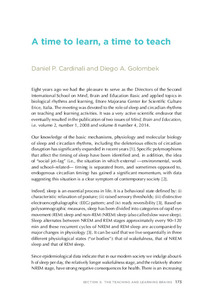Please use this identifier to cite or link to this item:
https://repositorio.uca.edu.ar/handle/123456789/1427| Título: | A time to learn, a time to teach | Autor: | Cardinali, Daniel Pedro Golombek, Diego A. |
Palabras clave: | MEDICINA; SUEÑO; CRONOBIOLOGIA | Fecha de publicación: | 2016 | Editorial: | Ettore Majorana Foundation and Centre for Scientific Culture | Cita: | Cardinali, D. P., Golombek, D. A. A time to learn, a time to teach [en línea]. En: Battro A. M., Fischer, K. W., Majdalani, M. .L, (eds.). Mind, brain and education at Erice : ten years. Ettore Majorana Foundation and Centre for Scientific Culture : Erice, 2016. Disponible en: https://repositorio.uca.edu.ar/handle/123456789/1427 | Resumen: | Abstract : Eight years ago we had the pleasure to serve as the Directors of the Second International School on Mind, Brain and Education Basic and applied topics in biological rhythms and learning, Ettore Majorana Center for Scientific Culture Erice, Italia. The meeting was devoted to the role of sleep and circadian rhythms on teaching and learning activities. It was a very active scientific endeavor that eventually resulted in the publication of two issues of Mind, Brain and Education, i.e. volume 2, number 1, 2008 and volume 8 number 4, 2014. Our knowledge of the basic mechanisms, physiology and molecular biology of sleep and circadian rhythms, including the deleterious effects of circadian disruption has significantly expanded in recent years. Specific polymorphisms that affect the timing of sleep have been identified and, in addition, the idea of “social jet–lag” (i.e., the situation in which external —environmental, work and school–related— timing is separated from, and sometimes opposed to, endogenous circadian timing) has gained a significant momentum, with data suggesting this situation is a clear symptom of contemporary society. Indeed, sleep is an essential process in life. It is a behavioral state defined by: (i) characteristic relaxation of posture; (ii) raised sensory thresholds; (iii) distinctive electroencephalographic (EEG) pattern; and (iv) ready reversibility [3]. Based on polysomnographic measures, sleep has been divided into categories of rapid eye movement (REM) sleep and non–REM (NREM) sleep (also called slow wave sleep). Sleep alternates between NREM and REM stages approximately every 90–120 min and these recurrent cycles of NREM and REM sleep are accompanied by major changes in physiology [3]. It can be said that we live sequentially in three different physiological states (“or bodies”): that of wakefulness, that of NREM sleep and that of REM sleep... | URI: | https://repositorio.uca.edu.ar/handle/123456789/1427 | Disciplina: | MEDICINA | Derechos: | Acceso Abierto | Fuente: | Battro A. M., Fischer, K. W., Majdalani, M. L., eds., Mind, brain and education at Erice : ten years. Ettore Majorana Foundation and Centre for Scientific Culture : Erice, 2016 |
| Appears in Collections: | Libros/partes de libro |
Files in This Item:
| File | Description | Size | Format | |
|---|---|---|---|---|
| time-learn-time-teach.pdf | 60,39 kB | Adobe PDF |  View/Open |
Page view(s)
156
checked on Apr 30, 2024
Download(s)
69
checked on Apr 30, 2024
Google ScholarTM
Check
This item is licensed under a Creative Commons License

